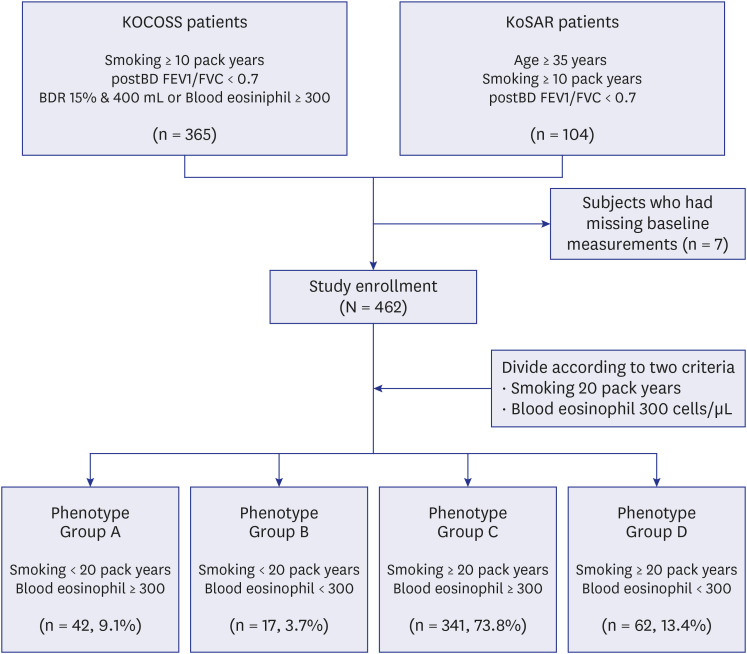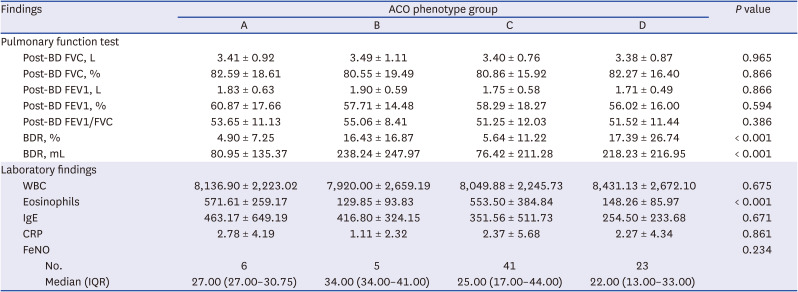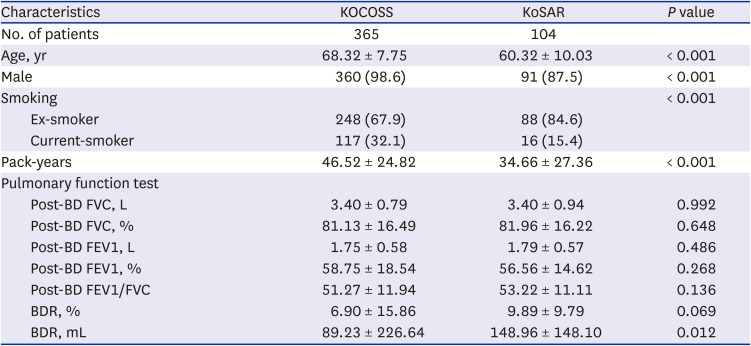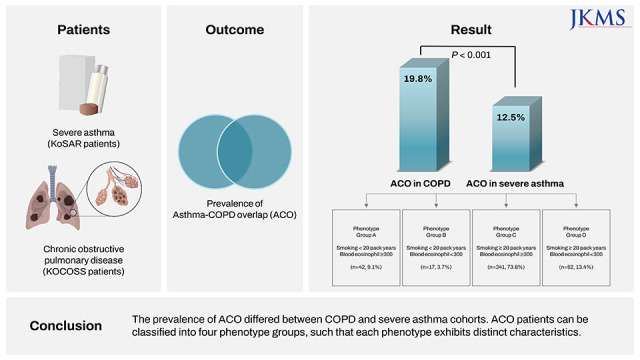1. Global Initiative for Asthma (GINA). Global strategy for asthma management and prevention. Updated 2021. Accessed April 15, 2017.
www.ginasthma.org
.
2. Lainez S, Court-Fortune I, Vercherin P, Falchero L, Didi T, Beynel P, et al. Clinical ACO phenotypes: description of a heterogeneous entity. Respir Med Case Rep. 2019; 28:100929. PMID:
31516821.

3. Miravitlles M, Soriano JB, Ancochea J, Muñoz L, Duran-Tauleria E, Sánchez G, et al. Characterisation of the overlap COPD-asthma phenotype. Focus on physical activity and health status. Respir Med. 2013; 107(7):1053–1060. PMID:
23597591.

4. Miravitlles M, Huerta A, Fernández-Villar JA, Alcázar B, Villa G, Forné C, et al. Generic utilities in COPD patients stratified according to different staging systems. Health Qual Life Outcomes. 2014; 12:120. PMID:
25189786.
5. Golpe R, Sanjuán López P, Cano Jiménez E, Castro Añón O, Pérez de Llano LA. Distribution of clinical phenotypes in patients with chronic obstructive pulmonary disease caused by biomass and tobacco smoke. Arch Bronconeumol. 2014; 50(8):318–324. PMID:
24576449.

6. Vaz Fragoso CA, Murphy TE, Agogo GO, Allore HG, McAvay GJ. Asthma-COPD overlap syndrome in the US: a prospective population-based analysis of patient-reported outcomes and health care utilization. Int J Chron Obstruct Pulmon Dis. 2017; 12:517–527. PMID:
28223792.
7. Alshabanat A, Zafari Z, Albanyan O, Dairi M, FitzGerald JM. Asthma and COPD overlap syndrome (ACOS): a systematic review and meta analysis. PLoS One. 2015; 10(9):e0136065. PMID:
26336076.

8. Barrecheguren M, Esquinas C, Miravitlles M. The asthma-chronic obstructive pulmonary disease overlap syndrome (ACOS): opportunities and challenges. Curr Opin Pulm Med. 2015; 21(1):74–79. PMID:
25405671.
9. Bonten TN, Kasteleyn MJ, de Mutsert R, Hiemstra PS, Rosendaal FR, Chavannes NH, et al. Defining asthma-COPD overlap syndrome: a population-based study. Eur Respir J. 2017; 49(5):1602008. PMID:
28461292.

10. Joo H, Han D, Lee JH, Rhee CK. Heterogeneity of asthma-COPD overlap syndrome. Int J Chron Obstruct Pulmon Dis. 2017; 12:697–703. PMID:
28260876.
11. Kim MH, Rhee CK, Kim K, Kim SH, Lee JY, Kim YH, et al. Heterogeneity of asthma and COPD overlap. Int J Chron Obstruct Pulmon Dis. 2018; 13:1251–1260. PMID:
29713158.

12. Rhee CK. Phenotype of asthma-chronic obstructive pulmonary disease overlap syndrome. Korean J Intern Med. 2015; 30(4):443–449. PMID:
26161009.

13. Kim MH, Kim SH, Park SY, Ban GY, Kim JH, Jung JW, et al. Characteristics of adult severe refractory asthma in Korea analyzed from the severe asthma registry. Allergy Asthma Immunol Res. 2019; 11(1):43–54. PMID:
30479076.

14. Lee H, Kim SH, Kim BK, Lee Y, Lee HY, Ban GY, et al. Characteristics of specialist-diagnosed asthma-COPD overlap in severe asthma: observations from the Korean Severe Asthma Registry (KoSAR). Allergy. 2021; 76(1):223–232. PMID:
33411398.

15. Plaza V, Álvarez F, Calle M, Casanova C, Cosío BG, López-Viña A, et al. Consensus on the asthma-COPD overlap syndrome (ACOS) between the Spanish COPD Guidelines (GesEPOC) and the Spanish Guidelines on the Management of Asthma (GEMA). Arch Bronconeumol. 2017; 53(8):443–449. PMID:
28495077.

16. Neumann T, Rasmussen M, Heitmann BL, Tønnesen H. Gold standard program for heavy smokers in a real-life setting. Int J Environ Res Public Health. 2013; 10(9):4186–4199. PMID:
24022655.

17. Lee YH, Shin MH, Kweon SS, Choi JS, Rhee JA, Ahn HR, et al. Cumulative smoking exposure, duration of smoking cessation, and peripheral arterial disease in middle-aged and older Korean men. BMC Public Health. 2011; 11(1):94. PMID:
21310081.

18. Singh D, Kolsum U, Brightling CE, Locantore N, Agusti A, Tal-Singer R, et al. Eosinophilic inflammation in COPD: prevalence and clinical characteristics. Eur Respir J. 2014; 44(6):1697–1700. PMID:
25323230.

19. Bafadhel M, Pavord ID, Russell RE. Eosinophils in COPD: just another biomarker? Lancet Respir Med. 2017; 5(9):747–759. PMID:
28601554.

20. Vedel-Krogh S, Nielsen SF, Lange P, Vestbo J, Nordestgaard BG. Blood eosinophils and exacerbations in chronic obstructive pulmonary disease. the Copenhagen General Population Study. Am J Respir Crit Care Med. 2016; 193(9):965–974. PMID:
26641631.

21. Yun JH, Lamb A, Chase R, Singh D, Parker MM, Saferali A, et al. Blood eosinophil count thresholds and exacerbations in patients with chronic obstructive pulmonary disease. J Allergy Clin Immunol. 2018; 141(6):2037–2047.e10. PMID:
29709670.
22. Gibson PG, Simpson JL. The overlap syndrome of asthma and COPD: what are its features and how important is it? Thorax. 2009; 64(8):728–735. PMID:
19638566.

23. Sin DD, Miravitlles M, Mannino DM, Soriano JB, Price D, Celli BR, et al. What is asthma-COPD overlap syndrome? Towards a consensus definition from a round table discussion. Eur Respir J. 2016; 48(3):664–673. PMID:
27338195.

24. Jo YS, Hwang YI, Yoo KH, Kim TH, Lee MG, Lee SH, et al. Comparing the different diagnostic criteria of asthma-COPD overlap. Allergy. 2019; 74(1):186–189. PMID:
30043981.










 PDF
PDF Citation
Citation Print
Print






 XML Download
XML Download